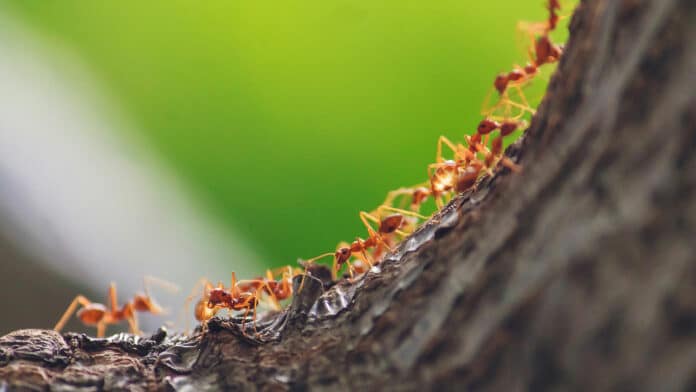Individual ants are relatively simple creatures, and yet a colony of ants can perform really complex tasks, such as intricate construction, foraging, and defense. Harvard researchers took inspiration from this emergent cooperative behavior of ants to design a team of relatively simple robots that can work collectively to perform complex tasks using only a few basic parameters.
The Harvard team started by studying how black carpenter ants work together to excavate out of and escape from a soft corral. At first, the ants inside the corral wandered around randomly, communicating via their antennae before they started working together to escape the corral.
The researchers observed that the ants would spontaneously congregate around areas where they interacted more often. Once a few ants started tunneling into the corral, others quickly joined in. Over time, excavation at one such location proceeded faster than at others, and the ants eventually tunneled out of the corral.
Based on their observations, the researchers identified two relevant parameters to understand the excavation task of the ants: the strength of collective cooperation and the rate of excavation. Numerical simulations of mathematical models that encode these parameters showed that the ants could successfully excavate only when they cooperate with each other sufficiently strongly while simultaneously excavating efficiently.
Driven by this understanding, the team built robotic ants, nicknamed RAnts, to see if they could work together to escape a similar corral. Instead of chemical pheromones, the RAnts used “photormones,” fields of light that are left behind by the roving RAnts that mimic pheromone fields or antennation.
The RAnts were programmed to follow three simple rules: they had to follow the gradient of the photoromone field, avoid other robots where photoromone density was high and pick up obstacles where photoromone density was high and move them to areas with low density. These three rules enabled the robotic ants to quickly escape their confinement and also allowed the researchers to explore regions of behavior that were hard to detect with real ants.
“We showed how the cooperative completion of tasks can arise from simple rules, and similar behavioral rules can be applied to solve other complex problems such as construction, search and rescue, and defense,” said S Ganga Prasath, co-lead author of the study.
This approach is highly flexible and robust to errors in sensing and control. The team says this could potentially be scaled up and applied to teams of dozens or hundreds of robots using a range of different types of communication fields. It’s also more resilient than other approaches to collaborative problem solving – even if a few individual robotic units fail, the rest of the team can complete the task.
Journal reference:
- S Ganga Prasath, Souvik Mandal, Fabio Giardina, Jordan Kennedy, Venkatesh N Murthy, L Mahadevan. Dynamics of cooperative excavation in ant and robot collectives. ELife, 2022; DOI: 10.7554/eLife.79638
